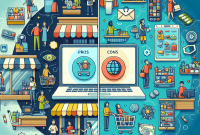
E-commerce Trends to Watch: What’s Next for Online Retail
E-commerce, or electronic commerce, has revolutionized the way we shop and do business. In recent years, the online retail industry has experienced significant growth, and the COVID-19 pandemic has further accelerated the shift towards e-commerce. As technology continues to advance and consumer behavior evolves, it’s crucial for online retailers to stay ahead of the curve by keeping an eye on emerging trends. In this article, we will explore the key e-commerce trends to watch and discuss what the future holds for online retail.
Personalization and Customer Experience
One of the most significant e-commerce trends to watch is the increasing demand for personalized shopping experiences. Consumers expect retailers to provide tailored recommendations, product suggestions, and customized promotions based on their preferences and past behavior. As a result, online retailers are investing in advanced data analytics and artificial intelligence to better understand their customers and deliver personalized experiences. For example, Amazon’s recommendation engine uses machine learning algorithms to suggest products based on a customer’s browsing and purchase history, improving both customer satisfaction and sales.
Mobile Shopping and M-commerce
With the widespread adoption of smartphones, mobile commerce, or M-commerce, has become a dominant force in the e-commerce landscape. As more consumers use their mobile devices to browse, shop, and make purchases, it’s essential for online retailers to optimize their websites and apps for mobile users. Mobile-friendly design, seamless checkout processes, and mobile payment options are critical for providing a smooth and convenient shopping experience. Moreover, the rise of mobile wallets and contactless payment methods has further accelerated the shift towards M-commerce, making it a key trend to watch in the coming years.
Omnichannel Retailing
Omnichannel retailing integrates online and offline channels to create a seamless shopping experience for customers. This trend recognizes that consumers often switch between various touchpoints, such as websites, mobile apps, social media, and physical stores, during their shopping journey. By offering a consistent and integrated experience across all channels, online retailers can improve customer engagement and loyalty. For instance, a customer might research a product online, visit a physical store to see it in person, and then make the purchase via a mobile app. Retailers that can effectively blend these channels will have a competitive edge in the e-commerce space.
Artificial Intelligence and Chatbots
Artificial intelligence (AI) and chatbots are revolutionizing customer service and support in the e-commerce industry. AI-powered chatbots can provide instant responses to customer inquiries, offer product recommendations, and even assist with the purchasing process. These chatbots use natural language processing and machine learning to understand and respond to customer queries, providing a personalized and efficient experience. For example, many e-commerce websites now feature chatbots that can help customers track orders, answer product questions, and resolve issues, enhancing the overall customer experience.
Sustainability and Ethical Practices
As consumers become more environmentally conscious and socially aware, there is a growing demand for sustainable and ethical practices in e-commerce. Online retailers are under pressure to reduce their environmental impact, source ethically produced products, and support social causes. Many consumers are willing to pay more for products from companies that demonstrate a commitment to sustainability and ethical business practices. In response, e-commerce brands are embracing eco-friendly packaging, implementing fair labor practices, and partnering with organizations to support social and environmental initiatives.
FAQs
What are some examples of successful personalized shopping experiences in e-commerce?
Some examples of successful personalized shopping experiences in e-commerce include Amazon’s recommendation engine, which provides customized product suggestions based on a customer’s browsing and purchase history, and Spotify’s personalized playlists, which are generated based on a user’s listening habits and preferences.
How can online retailers optimize their websites and apps for mobile users?
Online retailers can optimize their websites and apps for mobile users by using responsive design, minimizing load times, simplifying navigation, and offering mobile payment options. It’s also important to ensure that the checkout process is seamless and user-friendly on mobile devices.
What are some effective ways for online retailers to integrate online and offline channels in omnichannel retailing?
Some effective ways for online retailers to integrate online and offline channels in omnichannel retailing include offering in-store pickup for online orders, providing personalized promotions based on a customer’s online and offline interactions, and using RFID technology to track inventory across all channels.
Conclusion
The e-commerce industry is constantly evolving, driven by technological advancements, changing consumer behavior, and market dynamics. By staying abreast of the latest trends and innovations, online retailers can position themselves for success in the increasingly competitive e-commerce landscape. From personalization and mobile shopping to omnichannel retailing and sustainability, the future of online retail holds exciting opportunities for those willing to embrace change and adapt to shifting consumer expectations. By leveraging these emerging trends, online retailers can enhance the customer experience, drive sales, and build long-term relationships with their target audience.






